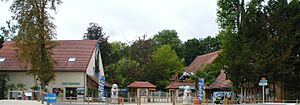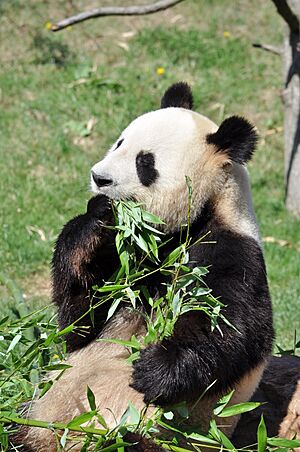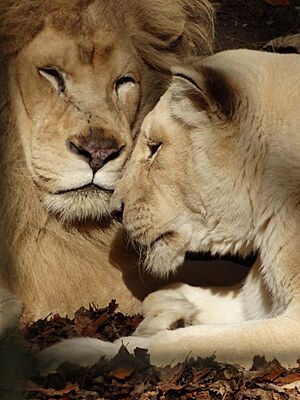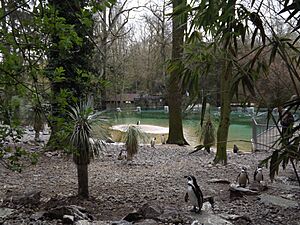ZooParc de Beauval facts for kids
 |
|

Main entrance
|
|
| Date opened | 1980 |
|---|---|
| Location | Saint-Aignan-sur-Cher, Centre, France |
| Land area | 40 hectares |
| Coordinates | 47°14′51″N 1°21′12″E / 47.24754°N 1.35336°E |
| No. of animals | 35,000 (2020) |
| No. of species | 800 (2020) |
| Annual visitors | 1.6 million |
| Memberships | EAZA, WAZA |
The ZooParc de Beauval, often called Beauval Zoo, is a famous animal park in France. It is located in Saint-Aignan-sur-Cher, in the Centre-Val de Loire region. This huge zoo is home to over 35,000 animals across 40 hectares. This makes it one of the largest animal collections in France and Europe.
The zoo was started in 1980 by Françoise Delord. Today, her son, Rodolphe Delord, runs the park. His family still owns most of the zoo. Beauval Zoo is known for being the first in France to have certain rare animals. For example, it was the first to show white tigers and white lions in the 1990s. Even now, many animals here are rare in France. These include okapis and tree kangaroos. Some animals, like the koala and the giant panda, are unique to this zoo in France.
Beauval Zoo has four special greenhouses. They are home to birds, great apes, sloths, reptiles, manatees, and animals from Australasia. There are also three large outdoor plains. Here you can see herbivores from the African savannah, like giraffes and white rhinos. Other plains feature African elephants and Asian herbivores. These include Indian rhinos and Malayan tapirs.
The park also has a Chinese area called "On China Heights." There is an African swamp called "The Hippos' Reserve." You can watch sea lions in "The Sea Lions' Odyssey." An outdoor theater hosts a bird show called "Masters of Airs." Beauval Zoo is part of the European Association of Zoos and Aquaria. It helps protect endangered species through special programs. The zoo also supports groups that work to save animals in their natural homes. It has even helped reintroduce some animals back into Africa.
Beauval Zoo is very popular. Since 2019, over 1.6 million people visit each year. It is the most visited tourist spot in its region. It is also one of the top five most visited zoos in France. The zoo offers places to stay, like an apartment hotel and two three-star hotels.
Contents
Zoo History
How Beauval Zoo Started
In the early 1970s, Françoise Delord loved birds. She started with a pair of African silverbills. Soon, she had hundreds of birds. By 1980, she had too many birds for her home in Paris. So, she moved with her family to Saint-Aignan-sur-Cher. There, she opened a bird park called Beauval. At first, it had about 1,500 to 2,000 birds. In 1989, Beauval became a full zoo. It welcomed its first mammals, including big cats and primates.
Major Milestones in the 1990s
In 1990, the zoo welcomed its first lions. A big moment came in 1991. Beauval became the first zoo in France to have white tigers. Their names were Gorby and Raïssa. These tigers made the zoo very famous. The number of visitors jumped from 70,000 to 150,000 that year.
In 1992, the zoo opened its first greenhouse. This was a tropical home for great apes. It housed Bornean orangutans and chimpanzees. Each group had large outdoor islands to explore. A vivarium for snakes and Nile crocodiles opened in 1993. In 1994, a second tropical greenhouse opened for 300 exotic birds.
The zoo built a sea lion pool in 1995. They started their first show with free-flying raptors and sea lions. A special nursery for young animals was created in 1996. In 1997, a third tropical greenhouse opened for gorillas and manatees. New homes for hyenas and African wild dogs were built in 1998. In 1999, the zoo welcomed a pair of white lions. They also created a large African plain. This plain was home to 80 animals of many species. These included springbok, sable antelope, blue wildebeest, Grévy's zebras, giraffes, and ostriches.
Growth in the 2000s
In 2000, three white rhinos joined the African Savannah. An Australian greenhouse opened in 2002. It became home to koalas, tree-kangaroos, and a marine aquarium. In 2003, the zoo grew by five hectares. This new space was for a group of five African elephants. They had a huge sandy park and a deep pool.
The vivarium was updated in 2004. It now housed over 250 reptiles. In 2005, okapis arrived. For five years, Beauval was the only zoo in France with okapis. A pool for Humboldt penguins was built in 2007. It had a large pool and a beach area. Giant anteaters also arrived that year.
In 2008, the zoo opened its first hotel, Les Jardins de Beauval. Sumatran tigers, the first non-white tigers at Beauval, also arrived. The Beauval Nature association was created in 2009. This group helps protect animals in the wild.
New Exhibits in the 2010s
In 2010, a large Asian plain was created. It housed Malayan tapirs, Indian rhinoceros, and many other Asian animals. A second koala, named Joey, was born. In 2011, a new area called "On China Heights" opened. It featured takins, snow leopards, red pandas, and Steller's sea eagles.
Amazing Animals at Beauval

Beauval Zoo has many different habitats for its animals. Each one is designed to make the animals feel at home.
The African Savannah
The African Savannah is a huge area. Many different African animals live here together. You can see giraffes, white rhinoceroses, Grevy's zebras, and wildebeest. There are also ostriches, Egyptian geese, and several types of antelope.
Australian House
The Australian House is a special place. It is one of the few zoos in Europe where you can see koalas. You can also spot Goodfellow's tree-kangaroos here. Inside, there is an aquarium with 1,500 types of fish. These fish come from Australia's Great Barrier Reef. Outside, you can find red kangaroos in large enclosures.
Manatee Basin
The Manatee Basin is home to a family of West Indian manatees. Beauval Zoo has been very successful at breeding manatees. The manatee tank is huge, holding 1,000 cubic meters of warm water. You can watch the manatees through a large glass wall. This pool also has Amazonian fish and river turtles. Manatees eat a lot, up to 50 kg of plants every day!
Tropical Greenhouse for Great Apes
This greenhouse is a warm home for many primates. You can see groups of chimpanzees and orangutans. They live on large outdoor islands. These islands give them plenty of space to explore. At the start of this house, there is a vivarium. It has over a hundred snakes, turtles, and American alligators. You can even see the alligators underwater! At the end of the house, there are smaller primates. These include emperor tamarins and pygmy marmosets.
Gorilla Complex
Next to the Manatee Basin is the Gorilla Complex. This is a huge greenhouse, 11 meters tall. It has free-flying ducks and birds like toucans. There is a lagoon with rays. A large indoor area is home to a family of gorillas. They have a 9-meter space to climb. The gorillas can also go outside to a big island.
Big Cats
Beauval Zoo has many different types of big cats. You can see:
- Sumatran tigers
- Jaguars (including black ones)
- Pumas
- White tigers
- White lions
- Persian leopards
You can also find spotted hyenas near the big cat areas.
Smaller Animals
Near the Gorilla Complex, there are four smaller enclosures. These are home to otters, red pandas, raccoons, and Barbary macaques.
Animal Shows
The zoo has exciting shows. One show features a family of Californian sea lions. There are also performing parrots and amazing birds of prey. All the sea lions in the show were born at Beauval.
The Hippos' Reserve
Opened in 2016, this exhibit is for a small group of hippopotamus. It also has nyala and red river hogs. The area looks like an African swamp. It has huge baobab trees. A metal net covers the top of the enclosure. This is because many African birds live here too, like hamerkops and Eurasian spoonbills.
The Equatorial Dome
The Equatorial Dome opened in 2020. It is Beauval's newest and biggest exhibit. This huge dome is 1 hectare in size and 38 meters tall. It is home to about 200 different species. Sunlight comes in through the glass roof. The dome is always kept warm at 26°C. Some of the star animals here are the Pygmy hippopotamus, the Giant otter, and the Harpy eagle. Soon, the Red-shanked douc langur will arrive. This species is very rare in zoos.



